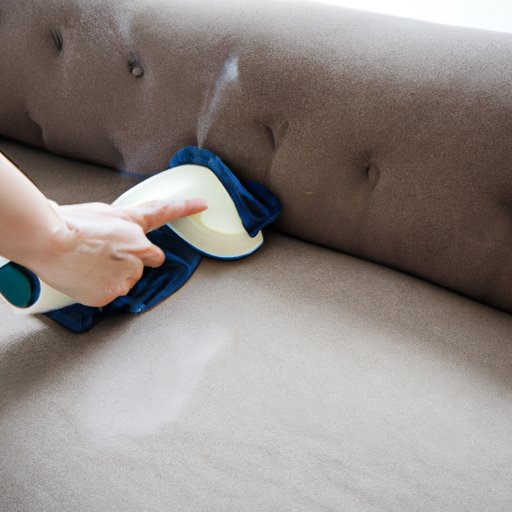I. Introduction
Dirty, stained couch cushions can be a major eyesore in any living space. Whether it’s from accidental spills or everyday use, keeping them clean can seem like an impossible task. But fear not! There are plenty of methods available to help make the process of cleaning couch cushions a breeze.
In this article, we’ll break down everything you need to know about cleaning your couch cushions, including natural cleaning methods, maintenance tips, and DIY cleaning solutions. Keep reading for a complete guide on how to restore your cushions to their former glory.
II. Step-by-Step Guide for Cleaning Couch Cushions
To get started, round up the materials and equipment you’ll need:
- Vacuum cleaner
- Cleaning agent (such as dish soap or specialized upholstery cleaner)
- Spray bottle
- Scrub brush or Cleaning cloth
Then follow these steps:
- Vacuum cushions thoroughly, paying close attention to any creases or folds where dirt and dust may accumulate
- Prepare a cleaning solution according to the instructions on your chosen cleaning agent, and spot test in a small area before applying to the entire cushion.
- Spot clean any stains on the cushion using a scrub brush or cleaning cloth dipped in the cleaning solution.
- Deep clean by spraying the cushion with the cleaning solution and using a scrub brush or cleaning cloth to clean it.
- Rinse the surface with water using a damp cloth or sponge and remove excess water and soap with another clean cloth or towel.
- Allow the cushions to dry completely. If possible, place them outside in the sun and fresh air or using fans.
By following these simple steps, your couch cushions will be looking clean and fresh in no time!
III. Use of Natural Methods for Cleaning Couch Cushions
For those who prefer natural cleaning materials, there are plenty of options available that can be just as effective as store-bought cleaners. Some popular ingredients for natural cleaning include:
- Vinegar
- Baking soda
- Essential oils
Here’s how to use these options for various types of stains and fabrics:
- For light stains on fabric cushions mix 1 cup of warm water with ½ cup of vinegar. Dip the cleaning cloth on the vinegar solution and clean the cushion.
- Baking soda is ideal for removing surface odors and light stains on the fabric. Simply sprinkle baking soda on the cushion, and let it sit for at least 30 minutes before vacuuming it.
- To add freshness and scent to your cushions, add a few drops of essential oil to your cleaning solution when spot-cleaning stains.
However, it’s important to be cautious when using natural cleaning solutions, especially if you’re dealing with tough stains or delicate fabric. Always spot test first to avoid causing more damage to the cushion.
IV. Maintenance Tips for Prolonging the Life of Couch Cushions
Regular maintenance is an important step in keeping your couch cushions clean and fresh. Here are some tips for creating a weekly cleaning routine:
- Vacuum cushions with a brush attachment to remove any dust, dirt and bits of food.
- Flip and rotate cushions every few weeks to help prevent uneven wear and tear and extend their lifespan.
- Avoid eating on your couch to reduce the amount of spills and crumbs on the cushions.
By following these simple maintenance tips, you can help avoid a deep cleaning situation down the line.
V. Cleaning Leather vs. Fabric Cushions
While the basic cleaning steps remain the same for leather and fabric cushions, there are some important differences you should know. If you have leather furniture, make sure to follow these steps:
- Wipe down your leather cushions regularly with a clean, dry cloth to remove surface dirt and dust.
- Use specialized leather cleaner to spot clean stains and dirt on the cushions, it’s safer and it helps in conditioning the surface.
- Condition your cushions every few months or as recommended to help prevent cracking and drying out.
Cleaning fabric cushions safely without damaging or discoloring the fabric is something to take seriously. Here are a few tips:
- Check your cushions before using any cleaning agents. Always read and follow the manufacturer’s instructions on cleaning and maintenance.
- For delicate fabrics, use a small amount of a gentle cleaning agent, and then rinse with plenty of water.
- Blot (not rub) any type of spill as fast as possible. Quick cleaning helps in preventing stains deep into the fabric.
VI. Tools and Equipment for Cleaning Couch Cushions
While the right cleaning product and technique are essential, there are also a few tools and equipment that can help make cleaning couch cushions easier and more effective:
- Steam cleaners are great for deeper cleaning and optional sanitizing.
- Upholstery brushes provide extra scrubbing power without damaging the fabric or leather surface
- Microfiber cloths are ideal for cleaning and drying cushions without leaving any marks or residue
When choosing cleaning equipment, keep in mind that the level of cleaning required is dependent on the cushions’ present condition.
VII. DIY Cleaning Agents for Couch Cushions
Household ingredients like dish soap, hydrogen peroxide, and baking soda can be used for cleaning couch cushions. Here’s how you can use these household products for various types of stains:
- A few drops of dish soap mixed with warm water can remove most stains easily.
- A solution of hydrogen peroxide and water can remove difficult blood, milk, or wine stains.
- Baking soda, mixed with water, is effective against odor as it absorbs smells and freshens fabrics.
Combined with natural cleaning solutions, these DIY alternatives can be quite effective, but it’s best to not use too much of them in cleaning the cushions to avoid damage.
VIII. Conclusion
Cleaning couch cushions doesn’t have to be a daunting task. By following the tips and steps outlined in this guide, you can maintain fresh, clean cushions that will look and feel good for years to come.
